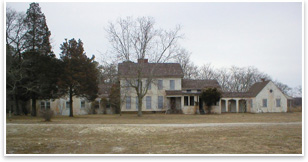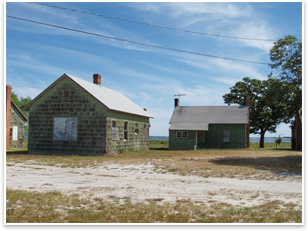
Summary: AIA Peconic, one of the Institute’s newest components, has launched the “Duck Project” as its AIA150 Blueprint for America chapter initiative, to study how to preserve and conserve a series of historic cottages in Flanders on the eastern end of Long Island in Southampton Township. The project site, where the Long Island Duck is an iconic trademark, is part of a 5,000-acre park preserve where the waterways nurture the area’s water supply system. Preservationist Eva Growney, AIA, is spearheading the study, which is rapidly garnering political and monetary support. Growney is leading the community-based effort to find uses for the series of existing historic buildings. With the support of chapter leadership and members, she is reaching out to many stakeholders. She first took it to the Department of Parks, Recreation & Conservation commissioner, with whom she has worked on many other preservation projects, and explained that the chapter would work with the community to study what the possibilities are in preserving and conserving the property. “The next few steps included meeting with all the immediate local governing agencies and getting their boards to approve their involvement, both by giving us funds, and by lending either their facilities, or connections with other agencies that might be helpful in exploring what this project could be used for,” Growney says.
She says plans are to make one of the buildings completely LEED-compliant and it will be a hands-on teaching tool that showcases the different methodologies of sustainable design. They also hope to take the building and make it into a completely self-sustaining structure. The other cottages could be used to house students who are studying the local ecosystem.
Growney and project organizers settled on the name the Duck Project to get away from “inside the profession” terminology, to honor the heritage of the site, and to make a connection with the public. “Things become much more intimate when people have an understanding about what the project is all about. Words like ‘regenerative sustainability’ are too big and cumbersome for the general public.” The Duck Project evokes the historic aspect, Growney says, and makes it a much more intimate endeavor that will encourage greater interest in what it is all about. |
||
Copyright 2007 The American Institute of Architects. All rights reserved. Home Page |
||
home
news headlines
practice
business
design
recent related
› Nevada’s AIA150 Blueprint for Livability
The flagship program of AIA150, the Blueprint for America engages the profession in service to communities across the nation, working collaboratively with government officials and business leaders, engaging citizens in dialogue, sharing basic community design principles, identifying neighborhood conditions in need of improvement, and, along the way, demonstrating the visionary role of architects in creating a better quality of life for all.
The AIA launched its nationwide Blueprint for America community service program on May 19, 2006, by awarding grants to 60 components. On October 13, 2006, the AIA awarded supplemental grants to an additional 96 components in support of their community visioning initiatives. View abstracts of current Blueprint for America initiatives.
Captions
Image 1:
Birdhouses overlooking Peconic Bay.
Image 2:
Black Duck Lodge front façade.
Image 3:
Smithers cabins.
Image 4:
Smithers Main House.


 And those contacts have embraced the project. “Legislators and assemblymen have contributed greatly in terms of their enthusiasm and their knowledge and facilitating the passage of other funding, locally, county, and statewide. We’re really making headway. Within the first three days I had $50,000 in commitments and within a couple of weeks we had about $100,000 of commitments,” Growney says. “What’s happening now, interestingly enough, is that local celebrities who have houses out here are getting interested in this project, as well as local business people.”
And those contacts have embraced the project. “Legislators and assemblymen have contributed greatly in terms of their enthusiasm and their knowledge and facilitating the passage of other funding, locally, county, and statewide. We’re really making headway. Within the first three days I had $50,000 in commitments and within a couple of weeks we had about $100,000 of commitments,” Growney says. “What’s happening now, interestingly enough, is that local celebrities who have houses out here are getting interested in this project, as well as local business people.” Celebratory on ducks
Celebratory on ducks The project is also fostering synergies with other entities. For example, the State University of New York at Stony Brook bought out the campus in Southampton and is planning on opening a school that’s based on sustainability. The interim dean invited Growney to look at the curriculum they are proposing for a sustainable architecture and planning design program, and told Growney the Duck Project “makes a perfect model for his new curriculum.”
The project is also fostering synergies with other entities. For example, the State University of New York at Stony Brook bought out the campus in Southampton and is planning on opening a school that’s based on sustainability. The interim dean invited Growney to look at the curriculum they are proposing for a sustainable architecture and planning design program, and told Growney the Duck Project “makes a perfect model for his new curriculum.”